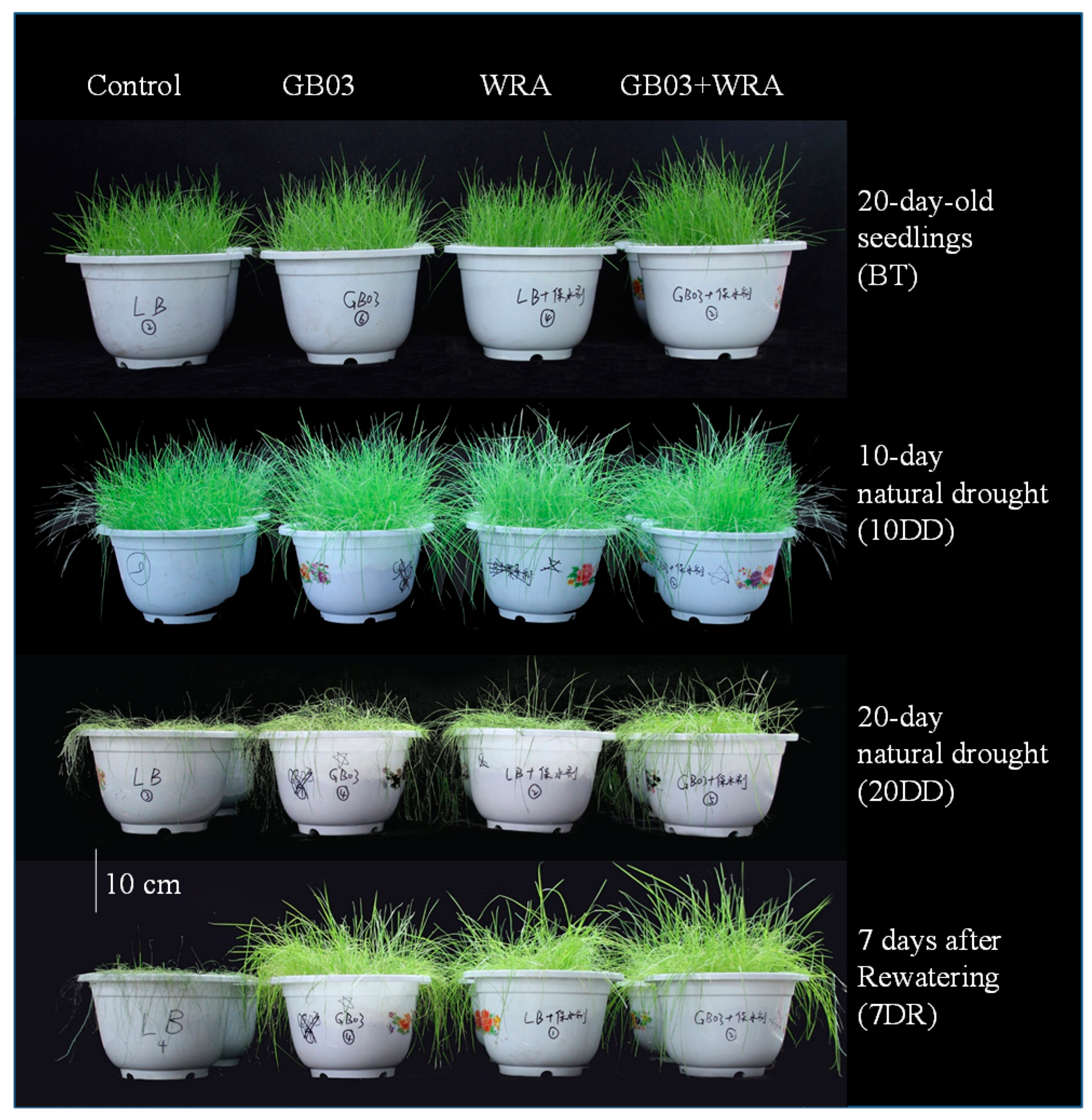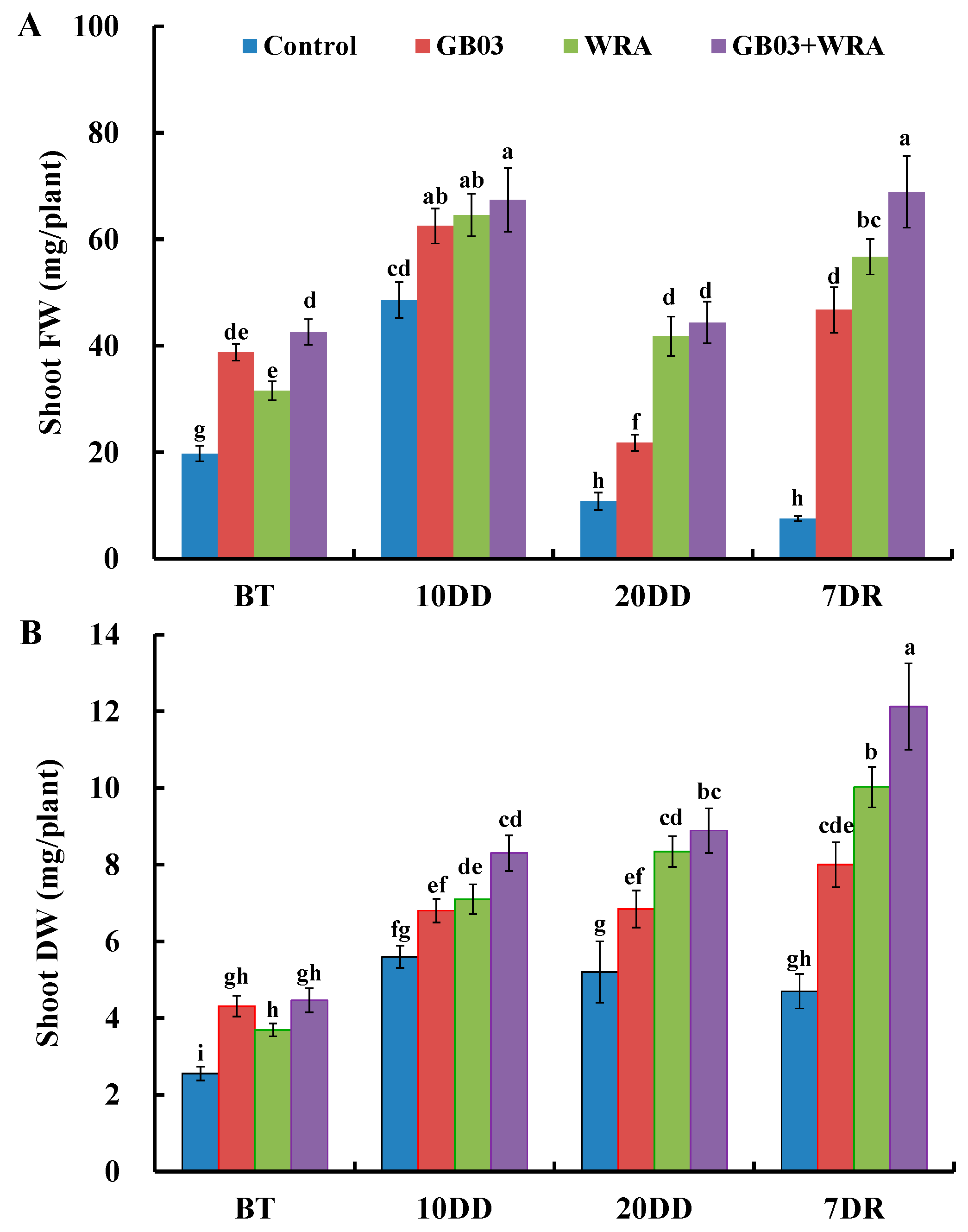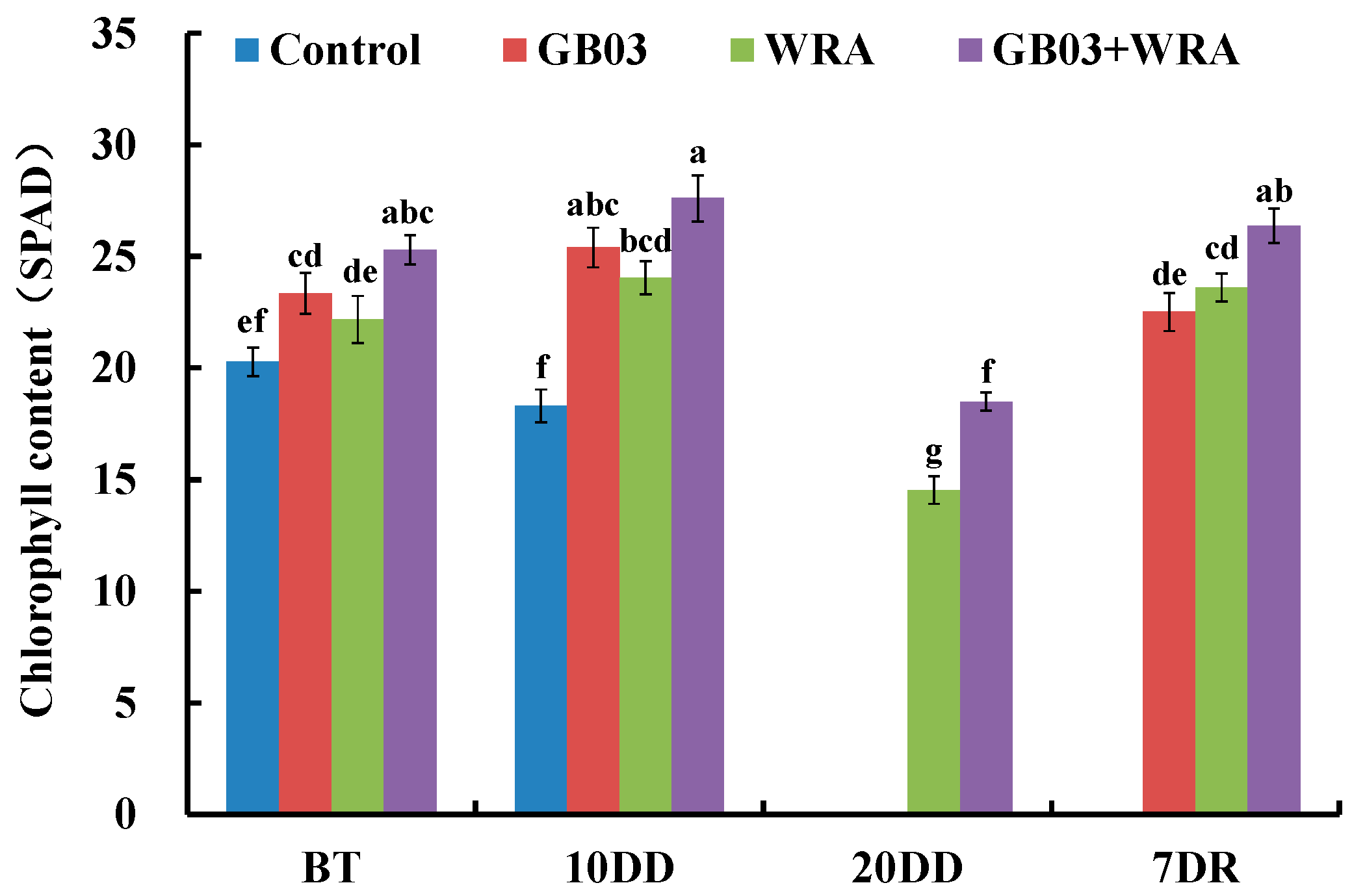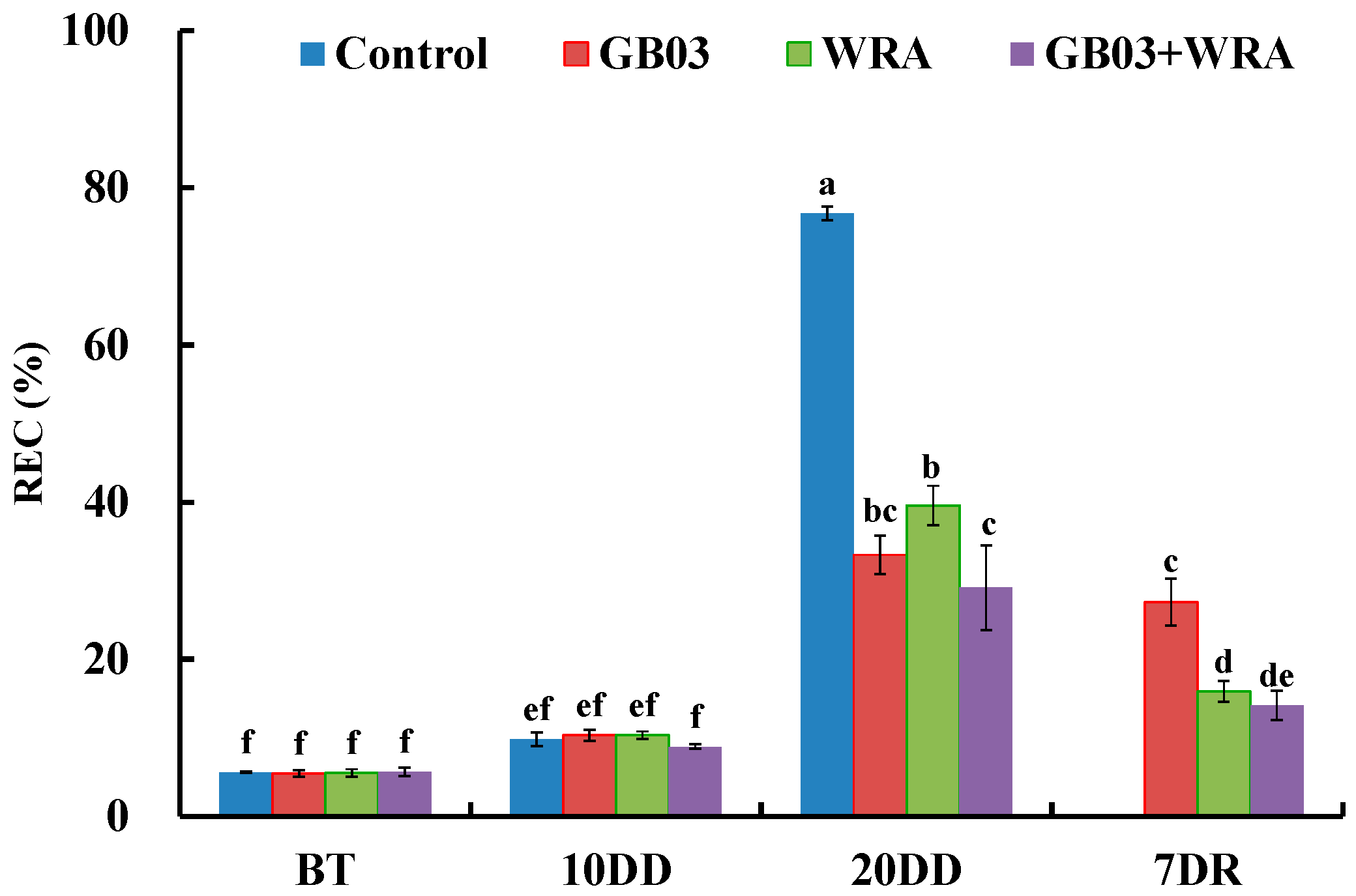Synergistic Effects of Bacillus amyloliquefaciens (GB03) and Water Retaining Agent on Drought Tolerance of Perennial Ryegrass
Abstract
:1. Introduction
2. Results
2.1. B. amyloliquefaciens GB03 and WRA Promoted Ryegrass Growth under Drought Condition
2.2. GB03 and WRA Maintained the Relative Water Content (RWC) under Drought Condition
2.3. GB03 and WRA Maintained Chlorophyll Content
2.4. GB03 and WRA Reduced Relative Electric Conductivity (REC) and MDA Content under Drought Stress
3. Discussion
3.1. Synergistic Effects of GB03 and WRA on Plant Growth under Drought Condition
3.2. GB03 and WRA Maintained Relatively Higher RWC Level in Ryegrass Leaves
3.3. Synergistic Effects of GB03 and WRA in Ryegrass Leaf Chlorophyll Content under Severe Drought Condition
3.4. GB03 and WRA Alleviated Cell Membrane Damage under Drought Conditions
4. Materials and Methods
4.1. Bacterial Suspension Culture
4.2. Plant Growth and Treatments
4.3. Plant Survival Rate, Biomass and Physiological Measurements
4.4. Data Analysis
5. Conclusions
Acknowledgments
Author Contributions
Conflicts of Interest
Abbreviations
| BT | Before drought treatment |
| CFU | Colony Forming Units |
| LB | Luria Broth |
| MDA | Malondialdehyde |
| PGPR | Plant Growth Promoting Rhizobacteria |
| REC | Relative electric conductivity |
| RWC | Relative Water Content |
| SEs | Standard errors |
| VOCs | Volatile Organic Compounds |
| WRA | Water Retaining Agent |
References
- Kramer, P.J.; Boyer, J.S. Water Relations of Plants and Soils; Academic Press: Cambridge, MA, USA, 1995. [Google Scholar]
- Hassine, A.B.; Bouzid, S.; Lutts, S. Does habitat of Atriplex halimus L. affect plant strategy for osmotic adjustment? Acta Physiol. Plant. 2010, 32, 325–331. [Google Scholar] [CrossRef]
- Wu, G.Q.; Xi, J.J.; Wang, Q.; Bao, A.K.; Ma, Q.; Zhang, J.L.; Wang, S.M. The ZxNHX gene encoding tonoplast Na+/H+ antiporter from the xerophyte Zygophyllum xanthoxylum plays important roles in response to salt and drought. J. Plant Physiol. 2011, 168, 758–767. [Google Scholar] [CrossRef] [PubMed]
- Martínez, J.P.; Kinet, J.M.; Bajji, M.; Lutts, S. NaCl alleviates polyethylene glycol-induced water stress in the halophyte species Atriplex halimus L. J. Exp. Bot. 2005, 56, 2421–2431. [Google Scholar] [CrossRef] [PubMed]
- Slama, I.; Ghnaya, T.; Messedi, D.; Hessini, K.; Labidi, N.; Savoure, A.; Abdelly, C. Effect of sodium chloride on the response of the halophyte species Sesuvium portulacastrum grown in mannitol-induced water stress. J. Plant Res. 2007, 120, 291–299. [Google Scholar] [CrossRef] [PubMed]
- Jaleel, C.A.; Manivannan, P.; Wahid, A.; Farooq, M.; Al-Juburi, H.J.; Somasundaram, R.; Panneerselvam, R. Drought Stress in Plants: A review on morphological characteristics and pigments composition. Int. J. Agric. Biol. 2009, 11, 100–105. [Google Scholar]
- Ma, Q.; Yue, L.J.; Zhang, J.L.; Wu, G.Q.; Bao, A.K.; Wang, S.M. Sodium chloride improves photosynthesis and water status in the succulent xerophyte Zygophyllum xanthoxylum. Tree Physiol. 2012, 32, 4–13. [Google Scholar] [CrossRef] [PubMed]
- Hendry, G.A.F. Oxygen, free radical processes and seed longevity. Seed Sci. Res. 1993, 3, 141–153. [Google Scholar] [CrossRef]
- Sgherri, C.L.M.; Maffei, M.; Navari-Izzo, F. Antioxidative enzymes in wheat subjected to increasing water deficit and rewatering. J. Plant Physiol. 2000, 157, 273–279. [Google Scholar] [CrossRef]
- Gholamhoseini, M.; Ghalavand, A.; Dolatabadian, A.; Jamshidi, E.; Khodaei-Joghan, A. Effects of arbuscular mycorrhizal inoculation on growth, yield, nutrient uptake and irrigation water productivity of sunflowers grown under drought stress. Agric. Water Manag. 2013, 117, 106–114. [Google Scholar] [CrossRef]
- Agnew, C.; Warren, A. A framework for tackling drought and land degradation. J. Arid Environ. 1996, 33, 309–320. [Google Scholar] [CrossRef]
- Egamberdieva, D.; Kucharova, Z. Selection for root colonising bacteria stimulating wheat growth in saline soils. Biol. Fertil. Soils 2009, 45, 563–571. [Google Scholar] [CrossRef]
- Timmusk, S.; Wagner, E.G. The plant-growth-promoting rhizobacterium Paenibacillus polymyxa induces changes in Arabidopsis thaliana gene expression: A possible connection between biotic and abiotic stress responses. Mol. Plant Microbe Interact. 1999, 12, 951–959. [Google Scholar] [CrossRef] [PubMed]
- Kloepper, J.W. Induced systemic resistance and promotion of plant growth by Bacillus spp. Phytopathology 2004, 94, 1259–1266. [Google Scholar] [CrossRef] [PubMed]
- Paré, P.W.; Zhang, H.; Aziz, M.; Xie, X.; Kim, M.-S.; Shen, X.; Zhang, J. Beneficial rhizobacteria induce plant growth: Mapping signaling networks in Arabidopsis. In Biocommunication in Soil Microorganisms; Springer: Berlin, Germany, 2011; pp. 403–412. [Google Scholar]
- Gao, S.; Wu, H.; Wang, W.; Yang, Y.; Xie, S.; Xie, Y.; Gao, X. Efficient colonization and harpins mediated enhancement in growth and biocontrol of wilt disease in tomato by Bacillus subtilis. Lett. Appl. Microbiol. 2013, 57, 526–533. [Google Scholar] [CrossRef] [PubMed]
- Ryu, C.-M.; Farag, M.A.; Hu, C.; Reddy, M.S.; Wei, H.; Paré, P.W.; Kloepper, J.W. Bacterial volatiles promote growth in Arabidopsis. Proc. Natl. Acad. Sci. USA 2003, 100, 4927–4932. [Google Scholar] [CrossRef] [PubMed]
- Ryu, C.-M.; Farag, M.A.; Hu, C.-H.; Reddy, M.S.; Kloepper, J.W.; Paré, P.W. Bacterial volatiles induce systemic resistance in Arabidopsis. Plant Physiol. 2004, 134, 1017–1026. [Google Scholar] [CrossRef] [PubMed]
- Zhang, H.; Kim, M.S.; Krishnamachari, V.; Payton, P.; Sun, Y.; Grimson, M.; Farag, M.A.; Ryu, C.M.; Allen, R.; Melo, I.S.; et al. Rhizobacterial volatile emissions regulate auxin homeostasis and cell expansion in Arabidopsis. Planta 2007, 226, 839–851. [Google Scholar] [CrossRef] [PubMed]
- Zhang, H.; Xie, X.; Kim, M.S.; Kornyeyev, D.A.; Holaday, S.; Paré, P.W. Soil bacteria augment Arabidopsis photosynthesis by decreasing glucose sensing and abscisic acid levels in planta. Plant J. 2008, 56, 264–273. [Google Scholar] [CrossRef] [PubMed]
- Zhang, H.; Sun, Y.; Xie, X.; Kim, M.S.; Dowd, S.E.; Paré, P.W. A soil bacterium regulates plant acquisition of iron via deficiency-inducible mechanisms. Plant J. 2009, 58, 568–577. [Google Scholar] [CrossRef] [PubMed]
- Zhang, J.L.; Aziz, M.; Qiao, Y.; Han, Q.Q.; Li, J.; Wang, Y.Q.; Shen, X.; Wang, S.M.; Paré, P.W. Soil microbe Bacillus subtilis (GB03) induces biomass accumulation and salt tolerance with lower sodium accumulation in wheat. Crop Pasture Sci. 2014, 65, 423–427. [Google Scholar] [CrossRef]
- Han, Q.-Q.; Lü, X.-P.; Bai, J.-P.; Qiao, Y.; Paré, P.W.; Wang, S.-M.; Zhang, J.-L.; Wu, Y.-N.; Pang, X.-P.; Xu, W.-B.; et al. Beneficial soil bacterium Bacillus subtilis (GB03) augments salt tolerance of white clover. Front. Plant Sci. 2014, 5, 525. [Google Scholar] [CrossRef] [PubMed]
- Niu, S.-Q.; Li, H.-R.; Paré, P.W.; Aziz, M.; Wang, S.-M.; Shi, H.; Li, J.; Han, Q.-Q.; Guo, S.-Q.; Li, J.; et al. Induced growth promotion and higher salt tolerance in the halophyte grass Puccinellia tenuiflora by beneficial rhizobacteria. Plant Soil 2015, 407, 217–230. [Google Scholar] [CrossRef]
- Karadağ, E.; Uzum, O.B.; Saraydin, D. Swelling equilibria and dye adsorption studies of chemically crosslinked superabsorbent acrylamide/maleic acid hydrogels. Eur. Polym. J. 2002, 38, 2133–2141. [Google Scholar] [CrossRef]
- Sojka, R.E.; Bjorneberg, D.L.; Entry, J.A.; Lentz, R.D.; Orts, W.J. Polyacrylamide in agriculture and environmental land management. Adv. Agron. 2007, 92, 75–162. [Google Scholar]
- Szögi, A.A.; Leib, B.G.; Redulla, C.A.; Stevens, R.G.; Mathews, G.R.; Strausz, D.A. Erosion control practices integrated with polyacrylamide for nutrient reduction in rill irrigation runoff. Agric. Water Manag. 2007, 91, 43–50. [Google Scholar] [CrossRef]
- Sepaskhah, A.R.; Shahabizad, V. Effects of water quality and PAM application rate on the control of soil erosion, water infiltration and runoff for different soil textures measured in a rainfall simulator. Biosyst. Eng. 2010, 106, 513–520. [Google Scholar] [CrossRef]
- Sepaskhah, A.R.; Bazrafshan-Jahromi, A.R. Controlling runoff and erosion in sloping land with polyacrylamide under a rainfall simulator. Biosyst. Eng. 2006, 93, 469–474. [Google Scholar] [CrossRef]
- El-Hamshary, H. Synthesis and water sorption studies of pH sensitive poly (acrylamide-co-itaconic acid) hydrogels. Eur. Polym. J. 2007, 43, 4830–4838. [Google Scholar] [CrossRef]
- Farrell, C.; Ang, X.Q.; Rayner, J.P. Water-retention additives increase plant available water in green roof substrates. Ecol. Eng. 2013, 52, 112–118. [Google Scholar] [CrossRef]
- Sojka, R.E.; Entry, J.A.; Fuhrmann, J.J. The influence of high application rates of polyacrylamide on microbial metabolic potential in an agricultural soil. Appl. Soil Ecol. 2006, 32, 243–252. [Google Scholar] [CrossRef]
- Galeş, D.C.; Trincă, L.C.; Cazacu, A.; Peptu, C.A.; Jităreanu, G. Effects of a hydrogel on the cambic chernozem soil’s hydrophysic indicators and plant morphophysiological parameters. Geoderma 2016, 267, 102–111. [Google Scholar] [CrossRef]
- Jobin, P.; Caron, J.; Bernier, P.-Y.; Dansereau, B. Impact of Two hydrophilic acrylic-based polymers on the physical properties of three substrates and the growth of Petunia ×hybrida ‘Brilliant Pink’. J. Am. Soc. Hortic. Sci. 2004, 129, 449–457. [Google Scholar]
- Hüttermann, A.; Orikiriza, L.J.B.; Agaba, H. Application of superabsorbent polymers for improving the ecological chemistry of degraded or polluted lands. Clean Soil Air Water 2009, 37, 517–526. [Google Scholar] [CrossRef]
- Agaba, H.; Orikiriza, L.J.B.; Obua, J.; Kabasa, J.D.; Worbes, M.; Hüttermann, A. Hydrogel amendment to sandy soil reduces irrigation frequency and improves the biomass of Agrostis stolonifera. Agric. Sci. 2011, 2, 544–550. [Google Scholar] [CrossRef]
- Hayat, R.; Ali, S. Water absorption by synthetic polymer (Aquasorb) and its effect on soil properties and tomato yield. Int. J. Agric. Biol. 2004, 6, 998–1200. [Google Scholar]
- Kane, K.H. Effects of endophyte infection on drought stress tolerance of Lolium perenne accessions from the Mediterranean region. Environ. Exp. Bot. 2011, 71, 337–344. [Google Scholar] [CrossRef]
- Buxton, D.R.; Mertens, D.R.; Fisher, D.S. Forage Quality and Ruminant Utilization; American Society of Agronomy, Crop Science Society of America, Soil Science Society of America: Madison, WI, USA, 1996. [Google Scholar]
- Wang, J.P.; Bughrara, S.S. Evaluation of drought tolerance for Atlas fescue, perennial ryegrass, and their progeny. Euphytica 2008, 164, 113–122. [Google Scholar] [CrossRef]
- Norris, I.B. Relationships between growth and measured weather factors among contrasting varieties of Lolium, Dactylis and Festuca species. Grass Forage Sci. 1985, 40, 151–159. [Google Scholar] [CrossRef]
- Xie, X.; Zhang, H.; Paré, P.W. Sustained growth promotion in Arabidopsis with long-term exposure to the beneficial soil bacterium Bacillus subtilis (GB03). Plant Signal. Behav. 2009, 4, 948–953. [Google Scholar] [CrossRef] [PubMed]
- Cavaglieri, L.; Orlando, J.; Rodríguez, M.I.; Chulze, S.; Etcheverry, M. Biocontrol of Bacillus subtilis against Fusarium verticillioides in vitro and at the maize root level. Res. Microbiol. 2005, 156, 748–754. [Google Scholar] [CrossRef] [PubMed]
- Chowdappa, P.; Mohan Kumar, S.P.; Jyothi Lakshmi, M.; Upreti, K.K. Growth stimulation and induction of systemic resistance in tomato against early and late blight by Bacillus subtilis OTPB1 or Trichoderma harzianum OTPB3. Biol. Control 2013, 65, 109–117. [Google Scholar] [CrossRef]
- Gagné-Bourque, F.; Mayer, B.F.; Charron, J.B.; Vali, H.; Bertrand, A.; Jabaji, S. Accelerated growth rate and increased drought stress resilience of the model grass Brachypodium distachyon colonized by Bacillus subtilis B26. PLoS ONE 2015, 10, 1–23. [Google Scholar] [CrossRef] [PubMed]
- El-Hady, O.A.; Wanas, S.A. Water and fertilizer use efficiency by cucumber grown under stress on sandy soil treated with acrylamide hydrogels. J. Appl. Sci. Res. 2006, 2, 1293–1297. [Google Scholar]
- Kim, S.; Iyer, G.; Nadarajah, A.; Frantz, J.M.; Spongberg, A.L. Polyacrylamide hydrogel properties for horticultural applications. Int. J. Polym. Anal. Charact. 2010, 15, 307–318. [Google Scholar] [CrossRef]
- Jarvis, P.G.; Jarvis, M.S. The water relations of tree seedlings. IV. Some aspects of the tissue water relations and drought resistance. Physiol. Plant 1963, 16, 215–235. [Google Scholar] [CrossRef]
- Sandhya, V.; Ali, S.Z.; Grover, M.; Reddy, G.; Venkateswarlu, B. Effect of plant growth promoting Pseudomonas spp. on compatible solutes, antioxidant status and plant growth of maize under drought stress. Plant Growth Regul. 2010, 62, 21–30. [Google Scholar] [CrossRef]
- Vardharajula, S.; Zulfikar Ali, S.; Grover, M.; Reddy, G.; Bandi, V. Drought-tolerant plant growth promoting Bacillus spp.: Effect on growth, osmolytes, and antioxidant status of maize under drought stress. J. Plant Interact. 2011, 6, 1–14. [Google Scholar] [CrossRef]
- Naveed, M.; Mitter, B.; Reichenauer, T.G.; Wieczorek, K.; Sessitsch, A. Increased drought stress resilience of maize through endophytic colonization by Burkholderia phytofirmans PsJN and Enterobacter sp. FD17. Environ. Exp. Bot. 2014, 97, 30–39. [Google Scholar] [CrossRef]
- Grover, M.; Madhubala, R.; Ali, S.Z.; Yadav, S.K.; Venkateswarlu, B. Influence of Bacillus spp. strains on seedling growth and physiological parameters of sorghum under moisture stress conditions. J. Basic Microbiol. 2014, 54, 951–961. [Google Scholar] [CrossRef] [PubMed]
- Dodd, I.C.; Zinovkina, N.Y.; Safronova, V.I.; Belimov, A.A. Rhizobacterial mediation of plant hormone status. Ann. Appl. Biol. 2010, 157, 361–379. [Google Scholar] [CrossRef]
- Nelson, D.E.; Repetti, P.P.; Adams, T.R.; Creelman, R.A.; Wu, J.; Warner, D.C.; Anstrom, D.C.; Bensen, R.J.; Castiglioni, P.P.; Donnarummo, M.G.; et al. Plant nuclear factor Y (NF-Y) B subunits confer drought tolerance and lead to improved corn yields on water-limited acres. Proc. Natl. Acad. Sci. USA 2007, 104, 16450–16455. [Google Scholar] [CrossRef] [PubMed]
- Mittler, R. Oxidative stress, antioxidants and stress tolerance. Trends Plant Sci. 2002, 7, 405–410. [Google Scholar] [CrossRef]
- Farooq, M.; Wahid, A.; Kobayashi, N.; Fujita, D.; Basra, S.M.A. Plant drought stress: Effects, mechanisms and management. Agron. Sustain. Dev. 2009, 29, 185–212. [Google Scholar] [CrossRef]
- Møller, I.M.; Jensen, P.E.; Hansson, A. Oxidative modifications to cellular components in plants. Annu. Rev. Plant Biol. 2007, 58, 459–481. [Google Scholar] [CrossRef] [PubMed]
- Zhang, H.; Kim, M.-S.; Sun, Y.; Dowd, S.E.; Shi, H.; Paré, P.W. Soil bacteria confer plant salt tolerance by tissue-specific regulation of the sodium transporter HKT1. Mol. Plant Microbe Interact. 2008, 21, 737–744. [Google Scholar] [CrossRef] [PubMed]
- Barrs, H.D.; Weatherley, P.E. A re-examination of the relative turgidity technique for estimating water deficits in leaves. Aust. J. Biol. Sci. 1962, 15, 413–428. [Google Scholar] [CrossRef]
- Peever, T.L.; Higgins, V.J. Electrolyte leakage, lipoxygenase, and lipid peroxidation induced in tomato leaf tissue by specific and nonspecific elicitors from Cladosporium fulvum. Plant Physiol. 1989, 90, 867–875. [Google Scholar] [CrossRef] [PubMed]
- Niu, M.; Huang, Y.; Sun, S.; Sun, J.; Cao, H.; Shabala, S.; Bie, Z. Root respiratory burst oxidase homologue-dependent H2O2 production confers salt tolerance on a grafted cucumber by controlling Na+ exclusion and stomatal closure. J. Exp Bot. 2017. [Google Scholar] [CrossRef] [PubMed]







| Treatments | Control | GB03 | WRA | GB03+WRA |
|---|---|---|---|---|
| Soil water content (mg/g·DW) | 37.7 ± 3.9 b | 33.3 ± 04.7 b | 61.8 ± 2.0 a | 62.4 ± 5.9 a |
© 2017 by the authors. Licensee MDPI, Basel, Switzerland. This article is an open access article distributed under the terms and conditions of the Creative Commons Attribution (CC BY) license (http://creativecommons.org/licenses/by/4.0/).
Share and Cite
Su, A.-Y.; Niu, S.-Q.; Liu, Y.-Z.; He, A.-L.; Zhao, Q.; Paré, P.W.; Li, M.-F.; Han, Q.-Q.; Ali Khan, S.; Zhang, J.-L. Synergistic Effects of Bacillus amyloliquefaciens (GB03) and Water Retaining Agent on Drought Tolerance of Perennial Ryegrass. Int. J. Mol. Sci. 2017, 18, 2651. https://doi.org/10.3390/ijms18122651
Su A-Y, Niu S-Q, Liu Y-Z, He A-L, Zhao Q, Paré PW, Li M-F, Han Q-Q, Ali Khan S, Zhang J-L. Synergistic Effects of Bacillus amyloliquefaciens (GB03) and Water Retaining Agent on Drought Tolerance of Perennial Ryegrass. International Journal of Molecular Sciences. 2017; 18(12):2651. https://doi.org/10.3390/ijms18122651
Chicago/Turabian StyleSu, An-Yu, Shu-Qi Niu, Yuan-Zheng Liu, Ao-Lei He, Qi Zhao, Paul W. Paré, Meng-Fei Li, Qing-Qing Han, Sardar Ali Khan, and Jin-Lin Zhang. 2017. "Synergistic Effects of Bacillus amyloliquefaciens (GB03) and Water Retaining Agent on Drought Tolerance of Perennial Ryegrass" International Journal of Molecular Sciences 18, no. 12: 2651. https://doi.org/10.3390/ijms18122651





